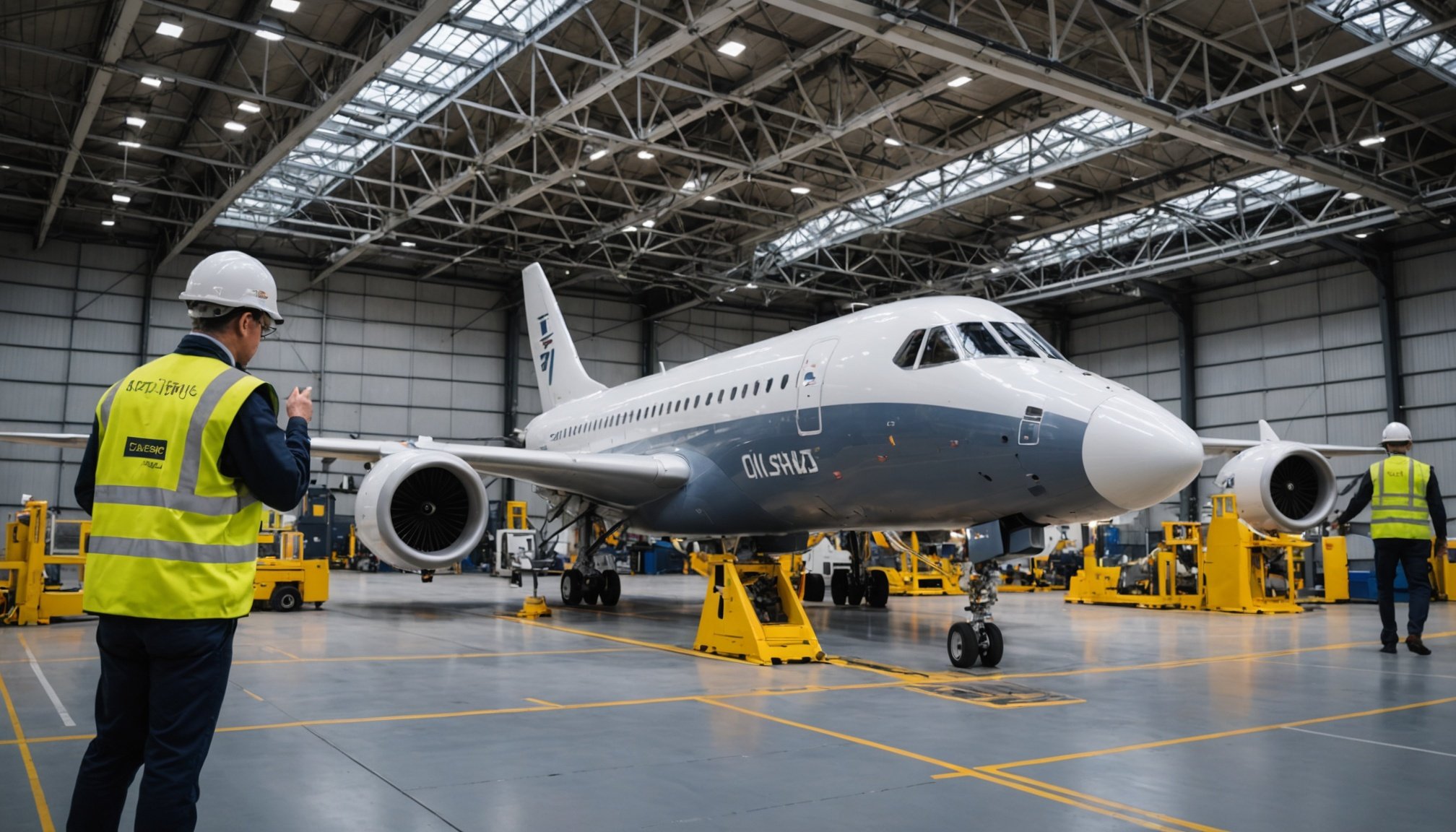Overview of AI in Predictive Maintenance
Predictive maintenance in the aerospace industry is revolutionising how aircrafts are serviced. This approach utilises various AI technologies to anticipate when maintenance should occur, rather than relying on routine schedules. The significance of predictive maintenance lies in its ability to minimise downtime and prevent unexpected failures, ensuring that aircrafts remain operational and safe.
AI Technologies Enhancing Predictive Maintenance
Diverse AI technologies are paving the way for more efficient predictive maintenance. For instance, machine learning plays a crucial role in analysing large datasets to identify patterns and predict potential issues before they become critical. Additionally, the Internet of Things (IoT) connects different components within an aircraft, enabling real-time monitoring and data collection. This synergy allows for more precise maintenance schedules and optimised aircraft performance.
Also read : Transforming patient outcomes: how ai is shaping the future of healthcare in uk hospitals
Adoption in the UK Aerospace Sector
The adoption rate of AI in predictive maintenance within the UK aerospace sector is steadily increasing. Many companies recognise the substantial benefits, which include reduced operational costs and improved safety standards. By leveraging these cutting-edge technologies, the industry is setting a benchmark for global aviation practices. However, there remains room for growth as more organisations strive to transition from traditional to AI-driven maintenance strategies.
Case Studies of AI Implementation in the UK Aerospace Industry
The UK aerospace industry is at the forefront of artificial intelligence technology, with several case studies highlighting innovative approaches and outcomes.
Also read : Harnessing ai: transforming customer experience in uk e-commerce for ultimate satisfaction
Example 1: Aerospace Manufacturer
One notable case involves an aerospace manufacturer implementing an AI solution to enhance production efficiency. The company adopted machine learning models to optimise supply chain management and predictive maintenance. This AI application enabled the company to anticipate equipment failures and reduce downtime, enhancing productivity significantly. Post-implementation, the manufacturer reported a substantial increase in production efficiency and a decline in operational costs. Key lessons from this case underscore the importance of data accuracy and the need for continuous model training to ensure optimal results.
Example 2: Airline Maintenance Operations
Similarly, an airline maintenance operation capitalised on AI systems for predictive analytics. This included deploying algorithms to forecast and prevent potential aircraft failures before they occurred. The impact on operational efficiency was profound, demonstrating a noticeable reduction in maintenance costs and improving aircraft turnaround time. With plans to expand AI integration, the airline aims to further refine its predictive models, enhance accuracy, and eventually reduce maintenance-related delays. This future integration highlights the potential for AI applications to transform operational strategies within the industry.
Benefits of AI-Driven Predictive Maintenance
Leveraging AI-driven predictive maintenance brings about significant benefits, primarily evident through improved efficiency and cost reduction. Predictive maintenance employs advanced analytics to forecast potential equipment failures before they occur, thereby minimizing downtime. This proactive approach results in substantial financial savings as it reduces the need for unexpected repairs and spare parts inventory costs.
Cost Benefits
The primary financial advantage is the reduction of unexpected failures, which can lead to costly emergency repairs. With predictive maintenance, repairs are scheduled when convenient, avoiding unnecessary expense. Companies can thus allocate budgets more accurately, investing saved resources into other strategic areas.
Increased Aircraft Availability and Reliability
In the aviation sector, predictive maintenance enhances aircraft availability and reliability. By identifying potential issues early, maintenance teams ensure that aircraft are less likely to experience unexpected groundings, contributing to higher utilisation rates. This increases airlines’ operational capacity, offering more flight options and improving customer satisfaction.
Data-Driven Decision Making
AI uses vast amounts of data to provide actionable insights, elevating decision-making to new heights. Maintenance teams can access precise analytics, helping them prioritize tasks and deploy resources optimally. This translates into tangible operational efficiencies, promoting a more streamlined and effective maintenance process.
Future Trends in AI and Predictive Maintenance
As innovation and technology evolution continue to shape industries, predictive maintenance stands out as a field witnessing significant transformations. Future trends indicate that Artificial Intelligence (AI) will see unprecedented advancements, driving efficiencies in predictive maintenance. With AI models becoming more sophisticated, the ability to predict machinery failures before they occur will enhance significantly, leading to cost savings and operational continuity.
Emerging technologies like blockchain and edge computing are set to play a pivotal role. Blockchain can ensure transparent and tamperproof service records, adding a layer of trust and reliability. Meanwhile, edge computing reduces latency by processing data closer to the source, enabling real-time analysis and quicker decision-making.
Potential changes in regulatory frameworks and industry standards could influence these trends. Governments and industry bodies may develop robust standards to ensure data privacy and compliance are maintained as these technologies proliferate. Keeping pace with these changes is crucial for businesses to remain competitive while leveraging AI for predictive maintenance optimally.
In conclusion, the seamless integration of future trends in AI with predictive maintenance promises not only to revolutionise operations but also to instigate a broader industrial transformation, pushing the boundaries of what is technologically achievable.
Challenges in Implementing AI for Predictive Maintenance
The implementation challenges of AI in predictive maintenance often stem from various barriers. Aerospace companies, for example, frequently encounter resistance to change within their organizational culture. This resistance can manifest as a reluctance to adopt new technologies, even when these innovations offer substantial benefits. Overcoming this requires a strategic approach.
One effective strategy is to emphasise the importance of training and skill development for personnel. By investing in comprehensive training programmes, organisations can ease the transition, thus enhancing familiarity and competence in using AI technologies. It is crucial to communicate the long-term benefits and practicality of AI systems, helping to align personnel with the organisation’s technology-driven vision.
Furthermore, it is vital to foster an adaptive mindset within the company. Encouraging open dialogue and feedback can dismantle barriers, facilitating smoother integration of AI tools. Regular workshops and discussions might be structured to showcase success stories, reinforcing the notion that AI implementation is not just a trend but a strategic requirement.
Finally, addressing technical infrastructure gaps, where existing systems may not support new AI technologies, is essential. By systematically identifying and upgrading these components, companies can lay a robust foundation for AI adoption in predictive maintenance.
Statistical Data and Expert Opinions
In examining how AI revolutionizes maintenance practices, data analysis reveals compelling statistics. A study by McKinsey suggested that AI-led maintenance could reduce workplace downtime by up to 30%. This highlights the critical role AI plays in optimizing maintenance strategies and minimizing operational disruptions.
Gaining expert insights into these trends, industry leaders emphasize AI’s transformative potential. Dr. Lucy Tan, a prominent AI researcher, noted that predictive analytics is reshaping maintenance schedules by identifying issues before they cause major interruptions. This proactive approach is proving crucial in high-stakes industries where delays are costly.
Recent research findings underscore AI’s influence on maintenance, especially in aerospace. For instance, a study from the Aerospace Industries Association found that AI applications have enhanced aircraft maintenance protocols, resulting in a 20% increase in reliability and safety. These developments are primarily due to AI’s ability to analyze vast amounts of data swiftly and accurately.
Moreover, AI’s success stories, such as Boeing’s use of AI for predictive maintenance, demonstrate significant improvements in efficiency. This ongoing evolution of AI-driven maintenance is not only boosting productivity but also encouraging further innovation in the field, marking a promising future ahead.






